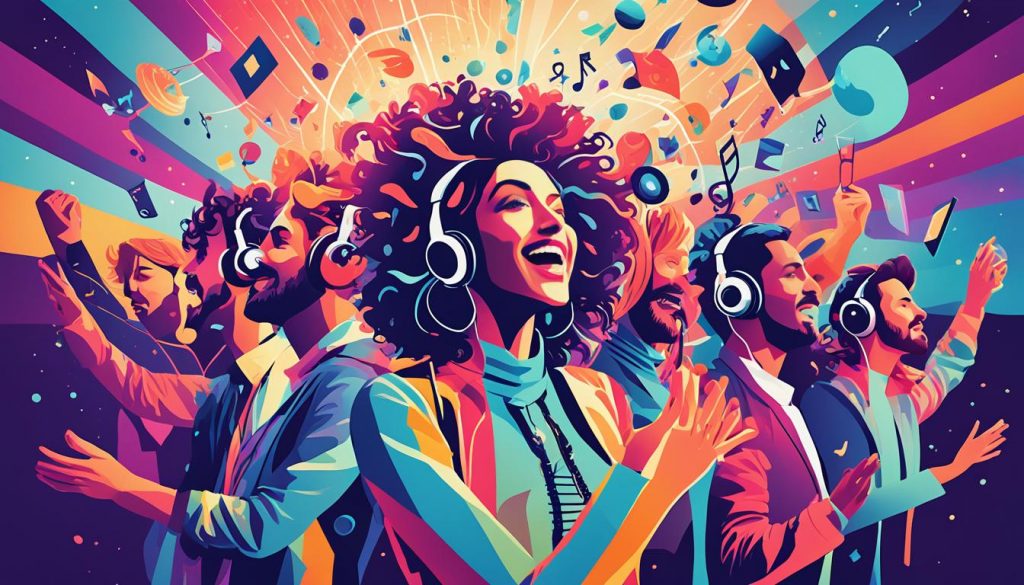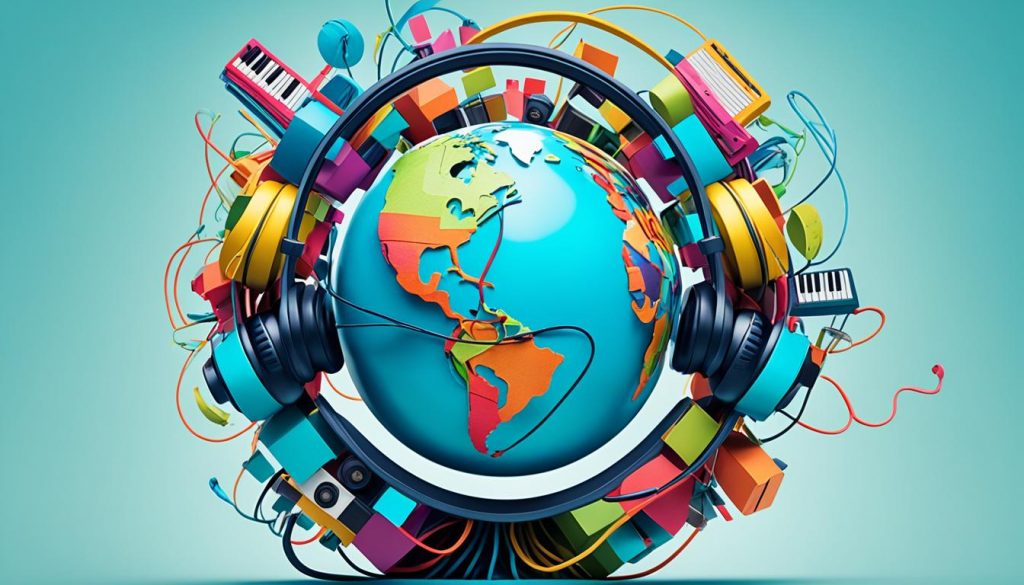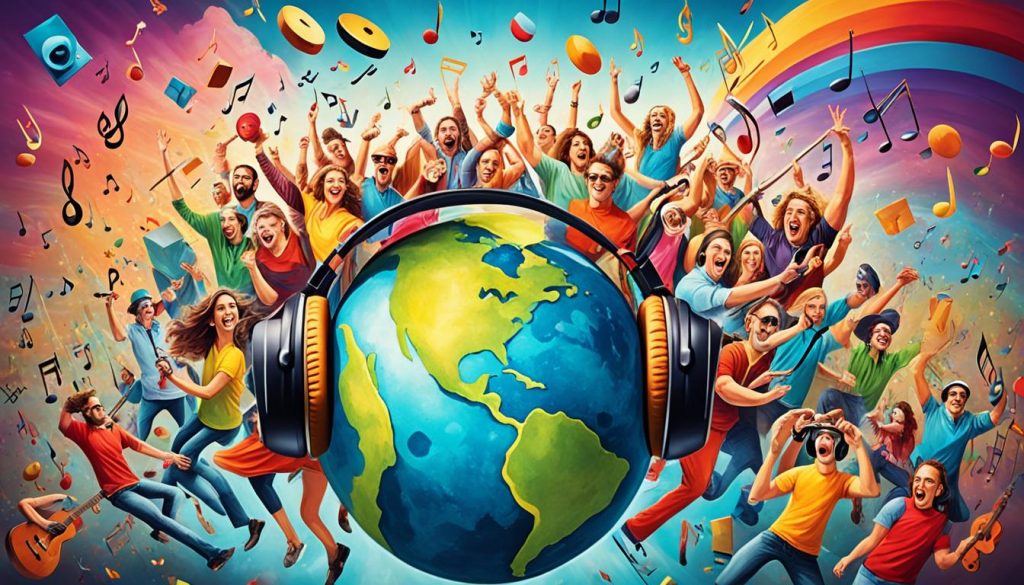Hey there! Welcome to my article on collaborative playlists, a feature that has taken the music world by storm. Are you a Spotify user looking for a way to connect with your friends and share your favorite tunes? Well, look no further because Spotify’s collaborative playlists have got you covered!
With millions of Spotify users already creating and enjoying collaborative playlists, this feature has become a fantastic way to bring music lovers together from around the world. Whether you’re planning a party, creating a themed playlist, or simply looking for new music recommendations, collaborative playlists on Spotify are the perfect solution.
Creating collaborative playlists is incredibly easy. All you need is a Spotify account, a group of friends, and a shared love for music. Let me show you how to get started!
But first, let’s talk about why collaborative playlists have become such a hit among music enthusiasts. The ability to curate a playlist together with your friends allows for a unique, shared musical experience. It’s a way to discover new songs, share personal favorites, and create a collective soundtrack that reflects the tastes and preferences of everyone involved.
In the next section, I’ll walk you through the simple steps to create your own collaborative playlist on Spotify. Get ready to unleash your inner DJ, and let the music collaboration begin!
How to Create Collaborative Playlists on Spotify
Creating collaborative playlists on Spotify is a breeze. Follow these simple steps to start curating a playlist with your friends and fellow music enthusiasts:
Step 1: Open Spotify
To get started, open the Spotify app or visit the Spotify website and navigate to the “Your Library” section.
Step 2: Create a New Playlist
Click on the “Create Playlist” button to begin creating a new playlist. Give your playlist a catchy name and description that reflects the theme or mood you envision for your collaborative playlist.
Step 3: Enable Collaboration
In order to enable collaboration, click on the three-dot menu icon next to your playlist. From the options that appear, select “Collaborative Playlist” to allow others to contribute to your curated collection.
Step 4: Share and Invite
Now it’s time to share your playlist with your friends! You can either share the playlist link directly with them or invite them through the Spotify app. Once they receive the invite, they can start adding songs to the collaborative playlist.
Your friends’ contributions will be visible to everyone who has access to the playlist, making it a true collective effort. Collaborative playlists on Spotify are just a few clicks away, so gather your music-loving friends and start creating your musical masterpiece today!
Best Practices for Spotify Collaborative Playlists
To create a successful and engaging collaborative playlist on Spotify, it’s helpful to follow some best practices and consider unique ideas. Here are some tips to make your collaborative playlist stand out:
1. Choose a theme
Select a specific genre, mood, or theme for your collaborative playlist to create a unique musical experience. Whether it’s a playlist for a road trip, a workout, a relaxing evening, or a specific musical era, having a theme adds cohesiveness to the playlist and makes it more appealing to listeners.
2. Crowdsource suggestions
Ask your collaborators to contribute their favorite songs that fit the playlist theme, creating a diverse and eclectic collection. This not only encourages active participation but also ensures that the playlist reflects the tastes and preferences of a larger audience.
3. Collaborate with influencers
Partner with influencers or music enthusiasts who have large followings to promote your collaborative playlist and attract more listeners. Their involvement can help increase the playlist’s visibility and broaden its reach.
4. Encourage engagement
Engage with your collaborators and listeners by asking for feedback, comments, or song recommendations. This creates a sense of community and encourages active participation. Respond to comments and acknowledge contributions to foster a positive and interactive environment.
5. Regular updates
Keep the playlist fresh by regularly adding new songs or rotating contributors to ensure a variety of musical styles and tastes. This keeps the playlist exciting and encourages listeners to return for new additions.
6. Share and promote
Share your collaborative playlist on social media, music forums, or through personal networks to reach a wider audience and encourage more collaboration. Use catchy captions, eye-catching visuals, and enticing descriptions to pique the interest of potential listeners.
The Impact of Collaborative Playlists During the COVID-19 Pandemic
The COVID-19 pandemic has had a profound impact on our lives, disrupting daily routines and isolating us from our social networks. During this challenging time, music has emerged as a powerful source of solace and connection. Collaborative playlists on Spotify have played a crucial role in bridging the gap between music lovers and providing a sense of community, even while physically distant.
As we navigated through lockdowns and stay-at-home orders, many individuals turned to music for comfort, finding solace in familiar tunes and discovering new releases. Collaborative playlists became a haven for these individuals, enabling them to share their favorite songs with others who were going through similar experiences. It became a virtual gathering place, where music served as the language that transcended social isolation.

Through collaborative playlists, people not only shared their favorite songs but also shared a piece of themselves. It became a way for individuals to express their emotions, connect with others, and maintain a sense of communal experience despite the physical separation. Whether it was creating playlists centered around a specific theme or simply exchanging recommendations, collaborative playlists fostered a feeling of togetherness and unity.
Music has always had the power to bring people together, and during the COVID-19 pandemic, collaborative playlists became a lifeline for social connection. They provided an outlet for creativity, an opportunity to discover new music, and a platform for shared experiences. In a time marked by social distancing, collaborative playlists on Spotify offered a glimpse of normalcy, reminding us that we were not alone in our musical journeys.
As we continue to navigate the challenges of the pandemic, collaborative playlists will undoubtedly continue to play a significant role in connecting music lovers, alleviating social isolation, and fostering a sense of community. The power of music to transcend boundaries and bring people together will always be relevant, reminding us of the power of shared experiences no matter the circumstances.
Spotify’s Jam: Taking Collaborative Listening to the Next Level
Spotify has introduced a new feature called Jam that brings collaborative listening to a whole new level. With Jam, Premium subscribers can create personalized, real-time listening sessions for their group, making it easier than ever to enjoy music together. This innovative feature allows users to invite others to contribute to a shared queue, resulting in a customized music experience that everyone can enjoy collectively.
What makes Jam even more special is its ability to enhance the collaborative aspect of music listening. With Jam, users can see who added which track to the queue, creating a sense of connection and shared appreciation for each other’s musical tastes. Whether it’s a social gathering, a party, or simply a gathering of friends and family, Jam provides the perfect platform for collaborative music exploration and enjoyment.
The Evolution of Perceptions and Usage of Collaborative Playlists During COVID-19
The COVID-19 pandemic has had a profound impact on our lives, including how we perceive and use collaborative playlists on Spotify. In a recent study conducted in the United States, researchers delved into the changing perceptions and usage patterns of collaborative playlists during the pandemic. The results revealed an intriguing shift in people’s attitudes towards these playlists and their increasing popularity as a tool for connection and musical exploration.
Since the onset of the pandemic, the interest in and usage of collaborative playlists have predominantly increased. People have begun to recognize the powerful role of music in bridging the social distance and forging connections during these challenging times. Collaborative playlists have become spaces for sharing and discovering music that resonates with our changing emotions and experiences.

The pandemic has highlighted the importance of communal experiences, even when physical proximity is restricted. Collaborative playlists offer a unique opportunity to connect with others through music, enabling us to discover new songs, share personal favorites, and curate collections that reflect our collective moods and sentiments.
Changing Perceptions of CPs
Collaborative playlists have also witnessed a shift in perception, evolving from mere curated collections to virtual spaces that foster social connection and shared experiences. People now view these playlists as more than just repositories of songs; they see them as platforms for self-expression and a medium to connect with the world outside their immediate surroundings. As our notions of physical space and social interactions have been challenged, collaborative playlists have emerged as powerful tools for maintaining a sense of community and togetherness.
This transformation in perception has opened up new avenues for exploration, creativity, and collaboration in the world of music streaming. It has sparked a deeper appreciation for the ways in which music can transcend physical barriers and unite us on a collective journey.
The Power of Music in Social Connection and Well-Being
Music has a remarkable ability to bring people together and enhance their well-being. It serves as a powerful tool for social connection, allowing individuals to express themselves, share experiences, and create meaningful bonds with others. Whether it’s attending a concert, singing along to a favorite song, or discussing musical preferences, music has the capacity to transcend cultural boundaries and foster a sense of unity.
Studies have shown that music can have a positive impact on mental health, reducing stress, anxiety, and depression. It has the power to uplift mood, evoke emotions, and provide a sense of comfort and solace. Listening to music activates the brain’s reward system, releasing dopamine and triggering feelings of pleasure and motivation.
Moreover, music has the unique ability to create shared experiences and forge connections between individuals. Whether it’s dancing together at a party, singing in a choir, or attending a music festival, these collective activities foster a sense of belonging and community. Music helps us connect with others on an emotional level, enabling us to build relationships and create lasting memories.

Overall, music’s role in social connection and well-being is undeniable. It has the power to unite people, promote empathy and understanding, and improve mental health. So, let’s celebrate the remarkable influence of music in our lives and continue to harness its potential to bring us closer together.
The Future of Collaborative Playlists on Spotify
As collaborative playlists continue to gain popularity and evolve, Spotify is constantly working on enhancing the collaborative experience for its users. The future of collaborative playlists on Spotify holds exciting possibilities, with the platform expected to introduce new features and enhancements.
One key area of improvement could be communication and interaction among collaborators. Spotify may explore the addition of chat features, allowing users to discuss songs, share recommendations, and engage in real-time conversations within the playlist.
In addition, real-time updates could be a game-changer for collaborative playlists. Users could see instant notifications when new songs are added, providing a dynamic and engaging experience.
Another fascinating potential enhancement could be the introduction of shared recommendations within the playlist. Spotify could use its data and algorithms to suggest songs based on the collective taste of the collaborators, leading to even more diverse and personalized playlists.
By continuously evolving and introducing new features, Spotify aims to further enhance collaborative experiences, making collaborative playlists a truly immersive and interactive platform for music lovers worldwide.

The Impact of Collaborative Playlists on Music Consumption and Discovery
Collaborative playlists have revolutionized the way we consume music and discover new artists. By allowing multiple users to contribute and curate songs, these playlists provide a dynamic platform for exploring a vast array of genres and musical styles that may not have been previously known.
Discovery through collaborative playlists is a powerful tool for music enthusiasts looking to broaden their horizon and dive into uncharted musical territories. By listening to songs recommended by others and contributing their own favorite tracks, users are exposed to a diverse range of music that goes beyond their usual listening habits.
Moreover, collaborative playlists have a profound impact on the music industry. They offer emerging and independent artists an opportunity to gain exposure and reach new audiences. As users add songs from lesser-known artists to their collaborative playlists, these musicians have a chance to be discovered by a wider audience who might not have come across their work otherwise.
Collaborative playlists also foster a sense of community among music lovers. Users can connect with others who share similar tastes and interests, forming virtual communities centered around specific genres or themes. This sense of belonging and shared experiences creates a vibrant atmosphere of music appreciation and opens up avenues for discussions, recommendations, and further exploration.
As collaborative playlists continue to grow in popularity, their impact on music consumption and discovery will only continue to broaden. From enhancing the visibility of independent artists to providing a platform for music enthusiasts to connect and share their passion, collaborative playlists have become a driving force in shaping the way we consume and explore music.
The Social and Cultural Significance of Collaborative Playlists
Collaborative playlists have transcended their status as a mere feature on a music streaming platform. They have evolved into a social and cultural phenomenon, shaping the way music enthusiasts connect and interact with each other. These playlists not only provide a platform for shared experiences but also serve as a reflection of the diverse musical tastes and preferences of the users who contribute.
Collaborative playlists hold great social significance as they foster connections and create a sense of community among music lovers. They bring people together, allowing individuals to contribute and curate a collective musical journey. Whether it’s a group of friends collaborating on a playlist for a road trip or a community of like-minded individuals sharing their favorite songs, collaborative playlists facilitate the formation of bonds and the forging of connections.
Furthermore, collaborative playlists have a profound cultural impact. They showcase the rich tapestry of musical genres, styles, and influences that exists within communities. These playlists reflect the cultural diversity and individuality of the contributors, providing a platform for self-expression and exploration. Collaborative playlists not only introduce listeners to new artists and genres but also create an environment where different musical cultures can coexist and flourish.
As a cultural phenomenon, collaborative playlists have become an embodiment of the collective musical consciousness. They capture the zeitgeist of music enthusiasts across the globe, encapsulating the ever-evolving landscape of popular culture. Collaborative playlists serve as a testament to the power of music to unite people, transcend boundaries, and embody the spirit of collaboration.
Conclusion: The Enduring Appeal of Collaborative Playlists
Collaborative playlists on Spotify have revolutionized the way music lovers connect and engage with music. These playlists have gained immense popularity, showcasing the enduring appeal and importance of collaborative music experiences. By allowing users to contribute and curate songs, collaborative playlists create a unique platform for music enthusiasts to come together, share their favorite tracks, and discover new music.
The enduring appeal of collaborative playlists lies in the sense of community and togetherness they foster. In a world where physical distance can separate us, these playlists provide a virtual space where individuals can connect, express themselves, and bond over a shared love for music. Whether it’s curating a playlist for a road trip or creating a mood-setting soundtrack for a party, collaborative playlists offer a means to create lasting memories and memorable experiences with friends and like-minded music enthusiasts.
The importance of collaborative music experiences cannot be understated. These playlists not only enhance our music listening journey but also promote diversity in musical taste and encourage exploration of new genres and artists. They serve as a powerful tool for music discovery, allowing us to expand our horizons and venture into uncharted musical territories.
As the future of music consumption continues to evolve, collaborative playlists will undoubtedly play a significant role. Their enduring appeal and ability to connect people through music make them an integral part of the music streaming experience. So, why listen to music alone when you can create, share, and collaborate on playlists with others? Embrace the power of collaborative playlists on Spotify and join the global community of music lovers united by the love of great music.
